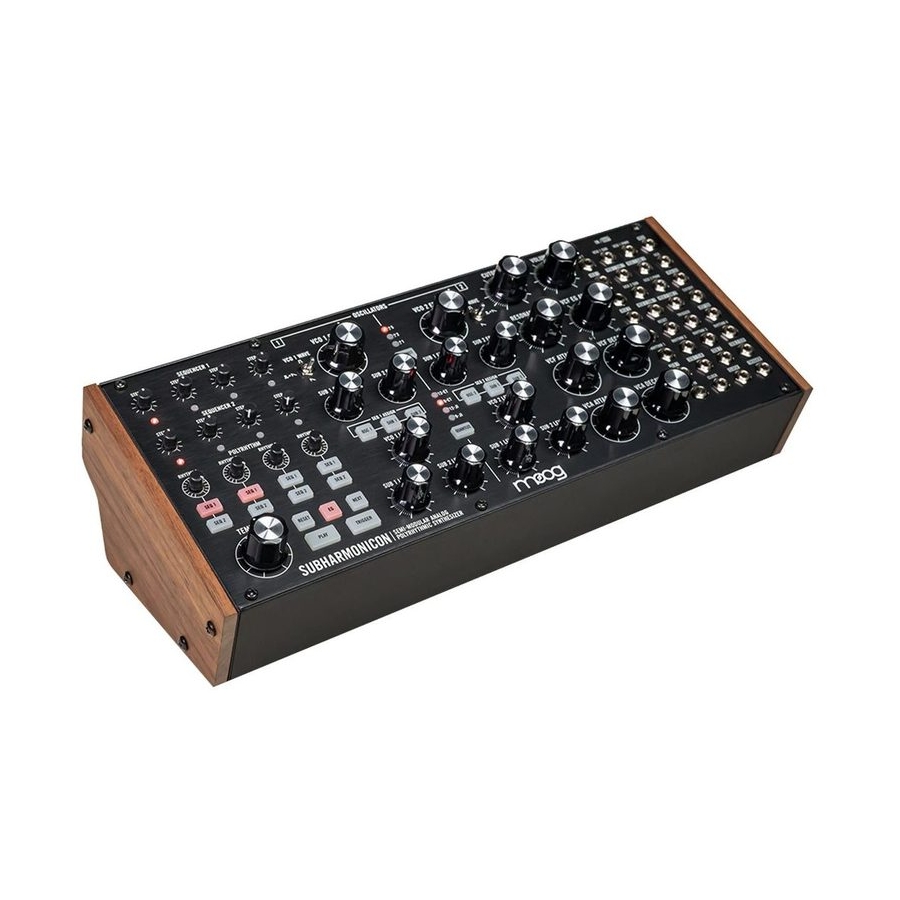
Summary of Contents for Moog Subharmonicon
- Page 1 Subharmonicon Patching with Intention Get started with patching techniques, explore deeper synthesis concepts, and understand full patchbay functionality...
- Page 2 Other times, however, you may want to patch with some intention. Perhaps you have a sound in mind that you would like Subharmonicon to approximate. Or an idea may strike you while falling asleep: “I wonder what would happen if I patched Sequencer 1 to the Filter Cutoff...”...
- Page 3 Initialized Patch Before getting started, match your Subharmonicon to the initialized patch settings above. Each section builds upon the last, so explore them in sequential order for the best results. Find full patch point descriptions on pages 12-15 to reference as you move through the patching exercises.
-
Page 4: First Steps
VCO 1 FREQ knob while rotating fully knob down to around 9 o’clock to hear counterclockwise sets them to -5 volts Subharmonicon’s sequencer in action. or 5 octaves below the VCO 1 FREQ knob. You will hear a procession of notes all at the same pitch—this is because although... - Page 5 Sequencers We have two methods of as you play with the sequencer knobs you will notice that the settings of both connecting a Subharmonicon sequencers affect the melody. sequencer to an oscillator: either via a patch cable, or with the Using two knobs per step as opposed buttons under SEQ 1/2 ASSIGN.
- Page 6 From Melody to Rhythm Using a combination of the SEQ → Exaggerate this effect by increasing ASSIGN buttons, patch cables, the RESONANCE and reducing the VCF DECAY. Do this slowly and listen to and the Polyrhythm section we how it changes as you approach max can start to create interesting RESONANCE.
- Page 7 Now you have an even more expressive While Subharmonicon does not have any drum machine! The settings of RHYTHMS LFOs, it does have sub-oscillators that can 1 + 2 as well as the frequency of both function in much the same way.
- Page 8 Make sure the EG button is illuminated, press PLAY, and turn the TEMPO down Envelopes to roughly 9 o’clock. Being a modular synthesizer, Subharmonicon can play with time by harnessing the power of voltage control over clocks, allowing us to accelerate and modulate time.
- Page 9 The benefit of using one of the oscillators as a clock is that the VCOs are voltage controllable—we can change the speed of the clock with voltages from elsewhere in Subharmonicon. Subharmonicon features two independent envelopes: one routed to the VCA Fun with Envelopes | 9...
- Page 10 This creates a very complex system, clock, our patterns are moving much and you can start to perceive that quicker than with the internal clock of Subharmonicon sounds like it almost Subharmonicon (which is much slower has a mind of its own. than the VCOs).
- Page 11 Further Exploration Now that you have some intuition for how Subharmonicon’s patch bay can be used, feel free to start exploring it on your own. Remember: there is no wrong way to patch—it’s all music at the end of the day.
- Page 12 Inputs Listed in order left to right by row; VCO 1 (R1, C1) R (Row) and C (Column) Controls the frequency of VCO 1 SEQ 1 can be patched to this input with the SEQ 1 ASSIGN buttons, but you can also connect SEQ 2 here, the VCA/VCF EG here for envelope modulation, or VCO 2 for frequency modulation.
- Page 13 VCO 2 Trigger continued... (R3, C1) Motion in either SEQ 1 or SEQ 2 will Controls the frequency of VCO 2 trigger this input, but you can patch the See VCO 1. CLOCK here to get faster triggers with SEQ 1 and SEQ 2 running at subdivisions VCO 2 SUB (R3, C2) of the clock.
- Page 14 (R1, C4) R (Row) and C (Column) Output of the final VCA This can be used to integrate Subharmonicon with Eurorack gear for further processing, or routed back into Subharmonicon for feedback patches. Try routing it to either VCO or the CUTOFF for noisy modulation.
- Page 15 CLOCK (R8, C3) This is normalled to the CUTOFF input, Master clock of Subharmonicon but try routing to any VCO for enveloping Patch to TRIGGER input to trigger FM or a RHYTHM for complex sequencer notes on every clock pulse regardless of motion.
- Page 16 www.moogmusic.com...














Need help?
Do you have a question about the Subharmonicon and is the answer not in the manual?
Questions and answers